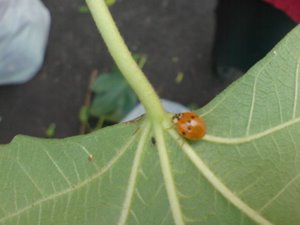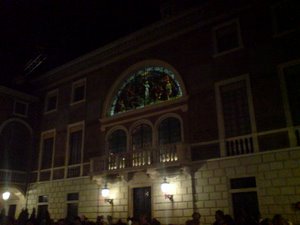Saturday, August 25, 2007
Tuesday, August 21, 2007
Thursday, August 16, 2007
Wednesday, August 15, 2007
Saturday, August 11, 2007
Wednesday, August 08, 2007
explanation of Ladybird photos (below)
Cut back the fig tree in the garden today, it had grown across the pavement.
Saw ladybirds, apparently England is under threat from Ladybirds, it's the terrorists' secret weapon.
or rather:
Britain's best-loved beetle, the ladybird, is under threat from the world's most invasive ladybird species - the harlequin ladybird (Harmonia axyridis).
A UK-wide survey, launched on Tuesday 15 March 2005 at the Natural History Museum, is calling for gardeners, farmers and wildlife enthusiasts to record any harlequin ladybirds they find.
The survey results will reveal how widely the harlequin has spread throughout Britain and provide vital information on the potential threat to the UK's native ladybirds.
An extremely voracious predator, the harlequin ladybird easily out-competes native ladybirds for its preferred food of green fly and scale insects. When these food sources are scarce they readily prey on native ladybirds and other insects such as butterfly eggs, caterpillars and lacewing larvae.
The harlequin ladybird was introduced to North America from Asia to control plant pests and, 20 years later, has become North America's commonest ladybird. First spotted in the UK in September 2004, sightings have mainly been confined to the south east of Britain.
‘The harlequin is a deadly threat to our own British ladybirds’, commented Dr Michael Majerus, for Cambridge University. ‘We need to monitor them closely in order to assess the spread and impact of the insect.’
Dr Helen Roy from Anglia Polytechnic University, one of the partners in the project, adds ‘monitoring ladybird populations has never been so important.’
http://www.nhm.ac.uk/about-us/news/2005/march/news_3416.html
http://www.harlequin-survey.org/
Saw ladybirds, apparently England is under threat from Ladybirds, it's the terrorists' secret weapon.
or rather:
Britain's best-loved beetle, the ladybird, is under threat from the world's most invasive ladybird species - the harlequin ladybird (Harmonia axyridis).
A UK-wide survey, launched on Tuesday 15 March 2005 at the Natural History Museum, is calling for gardeners, farmers and wildlife enthusiasts to record any harlequin ladybirds they find.
The survey results will reveal how widely the harlequin has spread throughout Britain and provide vital information on the potential threat to the UK's native ladybirds.
An extremely voracious predator, the harlequin ladybird easily out-competes native ladybirds for its preferred food of green fly and scale insects. When these food sources are scarce they readily prey on native ladybirds and other insects such as butterfly eggs, caterpillars and lacewing larvae.
The harlequin ladybird was introduced to North America from Asia to control plant pests and, 20 years later, has become North America's commonest ladybird. First spotted in the UK in September 2004, sightings have mainly been confined to the south east of Britain.
‘The harlequin is a deadly threat to our own British ladybirds’, commented Dr Michael Majerus, for Cambridge University. ‘We need to monitor them closely in order to assess the spread and impact of the insect.’
Dr Helen Roy from Anglia Polytechnic University, one of the partners in the project, adds ‘monitoring ladybird populations has never been so important.’
http://www.nhm.ac.uk/about-us/news/2005/march/news_3416.html
http://www.harlequin-survey.org/
Sunday, August 05, 2007
Saturday, August 04, 2007
Friday, August 03, 2007
Wednesday, August 01, 2007
Subscribe to:
Posts (Atom)
















